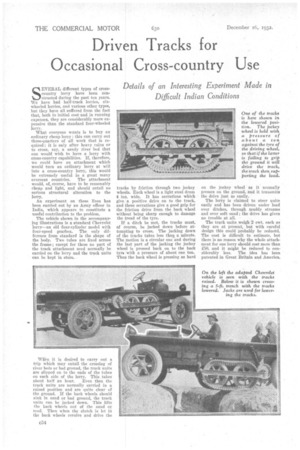Driven Tracks for Occasional Cross-country Use
Page 100

If you've noticed an error in this article please click here to report it so we can fix it.
Details of an Interesting Experiment Made in Difficult Indian Conditions
SEVERAL different types of crosscountry lorry have been constructed during the past ten years. We have had half-track lorries, sixwheeled lorries, and various other types, hut they have all suffered from the fact that, both in initial cost-and in running expenses, they are considerably more expensive than the standard four-wheeled lorry.
What everyone wants is to buy an ordinary cheap lorry ; this can carry out three-quarters of all work that is required; it is only after heavy rains or to cross, say, a sandy river bed that one would wish to have a lorry with cross-country capabilities. If, therefore, we could have an attachment which would turn an ordinary lorry at will into a cross-country lorry, this would be extremely useful in a great many overseas countries. The attachment would, of_ course, have to be reasonably cheap and light, and should entail no serious structural alteration to the lorry.
An experiment on these lines has been carried out by an Army officer in India, which appears to constitute a useful contribution to the problem.
The vehicle shown in the accompanying illustrations is a standard Chevrolet lorry—an old four-cylinder model with four-speed gearbox. The only difference from standard is the shape of the body. Two tubes are fixed across the frame; except for these no part of the track attachment need normally be carried on the lorry and the track units can be kept in store.
Wren it is desired to carry out a trip which may entail the crossing of river beds or bad ground, the track units are slipped on to the ends of the tubes on each side of the lorry. This .takes about half an hour. Even then the track units are normally carried in a raised position and are quite clear t,f the ground. If the back wheels should sink in sand or bad ground, the track units can be jacked down. This lifts the back wheels out of the sand or mud. Then when the clutch is let in the back wheels revolve and drive the
tracks by friction through two jockey wheels. Each wheel is a light steel drum 4 ins. wide. It has serrations which give a positive drive on to the track, and these serrations give a good grip for the friction drive from the back wheel without being sharp enough to damage the tread of the tyre.
If a ditch be met, the tracks must, of course, be jacked down before attempting to cross. The jacking down of the tracks takes less than a minute. The motion is a circular one and during the last part of the jacking the jockey wheel is pressed back on to the back tyra with a pressure of about one ton. Thus the back Wheel is pressing as hard on the jockey wheel as it normally presses on the ground, and it transmits the drive just as easily.
The lorry is claimed to steer quite easily and has been driven under load over ditches, through muddy streams and over soft sand; the drive has given no trouble at all.
The track units weigh 2 cwt each as they are at present, but with careful design this could probably be reduced. The cost is difficult to estimate, but there is no reason why the whole attachment for one lorry should cost more than £50, and it might be reduced to considerably less. The idea has been patented in Great Britain and America.




























































































































































